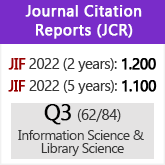Development of a thematic filter for the bibliometric delimitation on interdisciplinary area: the case of Marine Science
DOI:
https://doi.org/10.3989/redc.2008.v31.i2.428Keywords:
Marine Science, recall, precision, information retrieval, thematic delimitation, bibliometric studiesAbstract
In this methodological note, the recall and precision of a mixed thematic filter developed for the delimitation of the Marine Science area by means of specialised journals and keywords is analysed, and its efficiency is compared with a delimitation based only on scientific journals. The scientific production of Marine Science in Spain during 1994-2004 as covered by SCI, SSCI & AHCI is analysed. A high precision (96%) but a very low recall (close to 30%) is obtained by the delimitation strategy based only on scientific journals. The mixed filter presents a lower precision (69%) but a higher recall (around 75%). The journal-based delimitation provides an incomplete view of the area in which high-impact documents published in journals of other disciplines are ignored. The interest of developing advanced filters for the delimitation of scientific areas and the importance of expert opinions in order to obtain a balance between precision and recall are stressed.
Downloads
References
Aksnes, D.W.; Olsen, T.B.; Seglen, P.O. (2000). Validation of bibliometric indicators in the field of microbiology: a Norwegian case study. Scientometrics, 49(1): 7-22.
Bayers, N. (2005). Using ISI data in the analysis of German national and international research output. Scientometrics, 62(1), 155-163.
Bradford, S.C. (1934). Sources of information on specific subjects. Engineering, 137: 85-86
Costas, R.; Iribarren-Maestro, I. (2007). Variations in content and format of ISI database in their different versions: the case of the Science Citation Index in CD-ROM and the Web of Science. Scientometrics, vol. 72 (2):167-183.
Dastidar, P.G.; Ramachandran, S. (2005). Engineering research in ocean sector: An international profile. Scientometrics, vol. 65 (2), 199-213.
De Bruin, RE, Moed, H.F.(1993). Delimitation of scientific subfields using cognitive words from corporate address in scientific publications. Scientometrics vol. 26 (1), 65- 80.
Duarte, C.M.; Acuña, J.L.; Álvarez-Salgado, X.A.; Blasco, D.; Bordons, M.; Costas, R.; Dañobeitia, J.J.; Hernandez, S.; Losada, I.; Moralesnin, B.; Nombela, M.A.; Ruiz, J.; Zanuy, S. (2006). Las ciencias y tecnologías marinas en España. Madrid: CSIC.
Eto, H. (1999). The interest of scientific communities in sea-related research topics. Scientometrics, vol. 45 (2), 167-183.
Gattuso, J.P.; Dawson, N.A.; Duarte, C.M.; Middelburg, J.J. (2005). Patterns of publication effort in coastal biogeochemistry: a bibliometric survey (1971 to 2003). Marine Ecology Progress Series, vol. 264 (9-22), 9-22.
Glänzel, W.; Schubert, A.; Czerwon, H.J. (1999). An item-by-item subject classification of papers published in multidisciplinary and general journals using reference analysis. Scientometrics, vol. 44 (3), 427-439.
Gómez, I.; Bordons, M.; Morillo, F. (2005). Regionalisation of science and technology data in Spain. Research Evaluation, vol. 14 (2), 137-148. doi:10.3152/147154405781776193
Gómez, I.; Bordons, M.; Fernandez, M.T.; Mendez, A. (1996). Coping with the problem of subject classification diversity. Scientometrics, vol. 35 (2), 223-235.
Ínsua, A.; Tortosa, E. (1999). Análisis bibliométrico de la producción científica española en ciencias marinas. Informe de la Acción Especial Contribución del buque oceanográfico Hespérides a la producción científica española financiada por el Plan Nacional de I+D CICYT. Programa Nacional CYTMAR. Ref:.MAR96-1563. 1996-1997.
Lewison, G. (1996). The definition of biomedical research subfields with title keywords and application to the analisys of research outputs. Research Evaluation, vol. 6 (1), p.25- 36.
Lewison, G. (1999). The definition and calibration of biomedical subfields. Scientometrics, vol. 46 (3), 529-537.
Lundberg, J.; Fransson, A.; Brommels, M.; Skar, J.; Lundkvist, I. (2006). Is it better of just the same? Article identification strategies impact bibliometric assessments. Scientometrics, vol. 66 (1), 183-197.
Nederhof, A.J. (1991). Delimitation of a medical research topic: interaction with experts in selecting a database and constructing a search strategy. Research Evaluation, vol. 1 (3), 149-154.
OST. (2004). Indicateurs de Sciences et de Technologies: rapport de l’Observatoire des Sciences et des Techniques. France: OST
Pudovkin, A.I.; Fuseler, E.A. (1995). Indices of journal citation relatedness and citation relationships among aquatic biology journals. Scientometrics, vol. 32 (3), 227-236.
Rinia, E.J.; De Lange, C.; Moed, H.F. (1993). Measuring national output in physics: Delimitation problems. Scientometrics, vol. 28 (1), 89-110.
Sladek, R.; Tieman, J.; Fazekas, B.S.; Abernethy, A.P.; Currow, D.C. (2006). Development of a subject search filter to find information relevant to palliative care in the general medical literature. Journal of the Medical Library Association. 94(4): 394-401.
Tapaswi, M.P.; Maheswarappa, B.S. (1999). Ranking serials in oceanography: an analysis based on the contributions an their citations. Scientometrics, vol. 44 (1), 93-127.
Tuzi, F. (2005). The scientific specialisation of the Italian regions. Scientometrics, vol. 62 (1), 87-111.
Van Leeuwen, T.N. (2007). Modelling of bibliometric approaches and importance of output verification in research performance assessment. Research Evaluation, vol. 2 (1): 93-105. doi:10.3152/095820207X227529
Downloads
Published
How to Cite
Issue
Section
License
Copyright (c) 2008 Consejo Superior de Investigaciones Científicas (CSIC)

This work is licensed under a Creative Commons Attribution 4.0 International License.
© CSIC. Manuscripts published in both the printed and online versions of this Journal are the property of Consejo Superior de Investigaciones Científicas, and quoting this source is a requirement for any partial or full reproduction.All contents of this electronic edition, except where otherwise noted, are distributed under a “Creative Commons Attribution 4.0 International” (CC BY 4.0) License. You may read here the basic information and the legal text of the license. The indication of the CC BY 4.0 License must be expressly stated in this way when necessary.
Self-archiving in repositories, personal webpages or similar, of any version other than the published by the Editor, is not allowed.

















